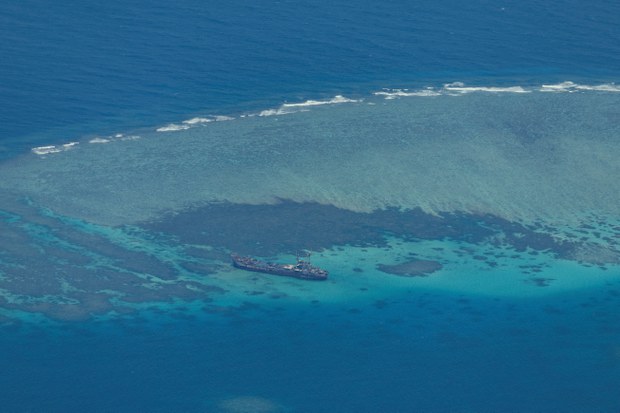Beijing, Manila trade blame over coral damage at disputed shoal
2024.07.09
 An aerial view shows the BRP Sierra Madre, a Philippine Navy ship deliberately grounded on the contested Second Thomas (Ayungin) Shoal in the South China Sea, March 9, 2023.
An aerial view shows the BRP Sierra Madre, a Philippine Navy ship deliberately grounded on the contested Second Thomas (Ayungin) Shoal in the South China Sea, March 9, 2023.
The Philippines on Tuesday rejected Chinese criticism that a navy ship grounded by Manila on a disputed reef in the South China Sea has damaged the coral ecosystem there.
The National Task Force for the West Philippine Sea dismissed Beijing’s accusation about the ship in Second Thomas (Ayungin) Shoal as “false and a classic misdirection.” The West Philippine Sea is Manila’s name for South China Sea waters within its exclusive economic zone.
“It is China who has been found to have caused irreparable damage to corals,” the task force said in a statement. “It is China that … jeopardized the natural habitat and the livelihood of thousands of Filipino fisherfolk.”
In 1999, Manila deliberately grounded the BRP Sierra Madre, an old warship, to serve as its military outpost in the reef. Confrontations there between the Philippine and Chinese coast guards have intensified in recent months.
On Monday, China released a survey report on the alleged damage caused by the Philippines to the reef at Second Thomas Shoal, which China calls Ren’ai Jiao, and is claimed by both countries.
The report, commissioned by China’s Ministry of Natural Resources, said that the “illegally grounded” BRP Sierra Madre had gravely damaged “the diversity, stability and sustainability of the coral reef ecosystem.”
It added that Chinese scientists conducted a survey through satellite remote sensing and field investigation in April and found that not only had the ship grounding process inflicted “fatal damage” on the coral reef, but its prolonged grounding also had “greatly inhibited the growth and recovery of corals in the surrounding area.”

China said photos released with the report showed dead corals underneath the Philippine warship, with researchers calculating that the aggregate coverage of reef-building corals at Ayungin had declined by 38.2%.
The report proposed that the Philippines promptly remove its ship from the shoal, “thereby eliminating the source of pollution, and preventing further sustained and cumulative damage to the coral reef ecosystem.”
China claims most of the South China Sea and all the islands and reefs within the so-called nine-dash line that it draws on maps to mark “historic rights” to the waters.
An international arbitral tribunal in 2016 ruled against all of China’s claims but Beijing refuses to accept the verdict.
‘Fake news and disinformation’
The Philippine task force called China’s survey report an attempt to “spread fake news and disinformation,” as well as to conduct “malign influence operations” against the Philippines.
It cited the 2016 arbitral award, which found that Chinese authorities were aware that their fishermen were harvesting endangered species on a substantial scale in the South China Sea using methods that inflicted severe damage on the coral reef environment. Additionally, they had not fulfilled their obligations to stop such activities, the task force said.
The Philippines has collated evidence that China has been responsible for severe damage to corals at a number of reefs in the disputed waters, it said, calling for an independent, third-party marine scientific assessment by impartial recognized experts.
The task force also invited neighboring countries to join the Philippines in “pushing for a more united, coordinated, and sustained multilateral action to protect and preserve the marine and land biodiversity in our region.”
The Asia Maritime Transparency Initiative (AMTI) at the U.S.-based Center for Strategic and International Studies said in a report last December that China had caused the most reef destruction through dredging and landfill while developing artificial islands in the South China Sea.
More than 6,200 acres (25 square km) of coral reef have been destroyed by island-building efforts in the South China Sea, with 75% of the damage – equivalent to roughly 4,648 acres (19 square km) – being done by China, according to AMTI.
Another 16,353 acres (66 square km) of coral reef were damaged due to giant clam harvesting operations by Chinese fishermen, it said.
China dismissed the AMTI report as “false” and said it was based on old satellite images.
Chinese officials maintain that China continues to give importance to protecting the environment in the South China Sea.
Radio Free Asia (RFA) is a news service affiliated with BenarNews. Jason Gutierrez for BenarNews in Manila contributed to this report.







